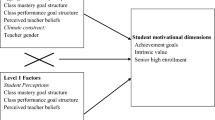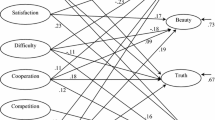Abstract
This paper examines the relationships between a number of affective variables included in models explaining gender differences in mathematics learning and a range of classroom environment dimensions more likely to be associated with effective mathematics learning. A large sample of 12–13 year old grade 7 students participated in the study. The data were explored at the individual level, for whole class groupings of students, and by gender. For individuals, three of the classroom environment measures were found to be associated with a subset of the affective variables. The patterns of the relationships in classroom learning environments where teacher support emerged as irrelevant were not the same for males and females, however. For class groupings of students, the same three classroom environment measures were related to the affective variables but their salience was different for males and females.
Similar content being viewed by others
References
Australian Education Council.: 1990, December. A national statement on mathematics for Australian schools, Curriculum Corporation, Carlton.
Benbow, C. P.: 1988, ‘Sex differences in mathematical reasoning ability in intellectually talented preadolescents: Their nature, effects, and possible causes’,Behavioral and Brain Sciences 11, 169–183.
Blane, D.: 1992, ‘Curriculum planning, assessment and student learning in mathematics: A top-down approach’, in G. C. Leder (ed.),Assessment and learning of mathematics, The Australian Council for Educational Research Ltd, Hawthorn, Victoria, pp. 290–304.
Clarke, D.: 1985, ‘The impact of secondary schooling and secondary mathematics on student mathematical behaviour’,Educational Studies in Mathematics 16, 231–257.
Clements, D. H. and M. T. Battista: 1990, ‘Constructivist learning and teaching’,Arithmetic Teacher 38(1), 34–35.
Fennema, E.: 1989, ‘The study of affect and mathematics: A proposed generic model for research’, in D. B. McLeod and V. M. Adams (eds.),Affect and mathematical problem solving, Springer-Verlag New York Inc., pp. 205–219.
Fennema, E. and P. Peterson: 1985, ‘Autonomous learning behavior: A possible explanation of gender-related differences in mathematics’, in L. C. Wilkinson and C. B. Marrett (eds.),Gender related differences in classroom interaction, Academic Press, New York, pp. 17–35.
Fennema, E. and J. Sherman: 1976, ‘Fennema-Sherman Mathematics attitude scales: Instruments designed to measure attitudes toward the learning of mathematics by females and males’,JSAS: Catalog of selected documents in psychology 6 (1), 31. (Ms. No. 1225).
Fennema, E., P. Wolleat, and J. D. Pedro: 1979, ‘Mathematics attribution scale’,JSAS: Catalog of selected documents in psychology 9(5, 26. (Ms. No. 1837)
Fraser, B. J.: 1990,Individualised Classroom Environment Questionnaire: Handbook, Australian Council for Educational Research, Hawthorn, Victoria.
Friedman, L.: 1989, ‘Mathematics and the gender gap: A meta-analysis of recent studies on sex differences in mathematical tasks’,Review of Educational Research 59(2, 185–213.
Hyde, J. S., E. Fennema, and S. J. Lamon: 1990, ‘Gender differences in mathematics performance: A meta-analysis’,Psychological Bulletin 107(2, 139–155.
Hyde, J. S., E. Fennema, M. Ryan, L. A. Frost, and C. Hopp: 1990, ‘Gender comparisons of mathematics attitudes and affect: A meta-analysis’,Psychology of Women Quarterly 14, 299–324.
Jungwirth, H.: 1991, ‘Interaction and gender — findings of a microethnographical approach to classroom discourse’,Educational Studies in Mathematics 22, 263–284.
Kilpatrick, J.: 1987, ‘What constructivism might be in education’, in J. C. Bergeron, N. Herscovics, and C. Kieran (eds.),Proceedings of the Eleventh Conference of the International Group for the Psychology of Mathematics Education, Université Montréal, Montréal, pp.3–27.
Koehler, M. S., and D. A. Grouws: 1992, ‘Mathematics teaching practices and their effects’. in D. A. Grouws (ed.),Handbook of research on mathematics teaching and learning, Macmillan Publishing Company, New York, pp. 115–126.
Leder, G. C.: 1992, ‘Mathematics and gender: Changing perspectives’. in D. A. Grouws (ed.),Handbook of research on mathematics teaching and learning, Macmillan Publishing Company, New York, pp.597–622.
Leder, G. C.: 1993, ‘Teacher/student interactions in the mathematics classroom: A different perspective’, in E. Fennema and G. C. Leder (eds.),Mathematics and gender, Queensland University Press, Queensland, Australia, pp. 149–168.
Leder, G. and H. Forgasz: 1992, ‘Gender: A critical variable in mathematics education’, in B. Atweh and J. Watson (eds.),Research in mathematics education in Australasia 1988–1991, Mathematics Education Research Group of Australasia, Queensland, pp.67–95.
Leder, G. C. and H. J. Forgasz: in press, ‘Girls and mathematics: Research for action’, in J. Pegg and L. Grimison (eds.).Teaching secondary mathematics: Theory into practice, Harcourt Brace, Sydney, Australia.
Ministry of Education (Schools division): 1988, The mathematics framework: P-10, Author, Victoria.
Nickson, M.: 1992, ‘The culture of the mathematics classroom: An unknown quantity?’. in D. A. Grouws (ed.),Handbook of research on mathematics teaching and learning, Macmillan Publishing Company, New York, pp.101–114.
Reyes, L. H.: 1984, ‘Affective variables and mathematics education’,The Elementary School Journal 84(5, 558–581.
Romberg, T. A., and T. P. Carpenter: 1986, ‘Research on teaching and learning mathematics: Two disciplines of scientific inquiry’. in M. C. Wittrock (ed.),Third handbook of research on teaching, Macmillan, New York, pp.850–873.
Shaughnessy, J., T. Haladyna, and J. M. Shaughnessy: 1983, ‘Relations of student, teacher, and learning environment variables to attitude toward mathematics’,School Science and Mathematics 83(1, 21–37.
Schoenfeld, A. H.: 1992, ‘Learning to think mathematically: Problem solving, metacognition and sense making in mathematics’. in D. A. Grouws (ed.),Handbook of research on mathematics teaching and learning, Macmillan Publishing Company, New York, pp.334–370.
Tabachnick, B. G. and L. S. Fidell: 1989, Using multivariate statistics (2nd Ed.), Harper Collins Publishers, New York.
Thompson, A. G.: 1992, ‘Teachers' beliefs and conceptions: A synthesis of the research’, in D. A. Grouws (ed.),Handbook of research on mathematics teaching and learning, Macmillan Publishing Company, New York, pp. 127–146.
Victorian Curriculum and Assessment Board [VCAB]: 1990, Mathematics study design. Author, Carlton, Victoria.
Author information
Authors and Affiliations
Rights and permissions
About this article
Cite this article
Forgasz, H.J. Gender and the relationship between affective beliefs and perceptions of grade 7 mathematics classroom learning environments. Educ Stud Math 28, 219–239 (1995). https://doi.org/10.1007/BF01274174
Issue Date:
DOI: https://doi.org/10.1007/BF01274174




